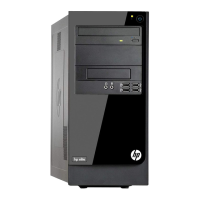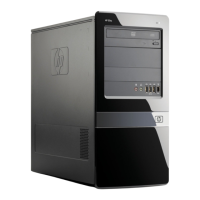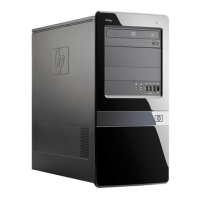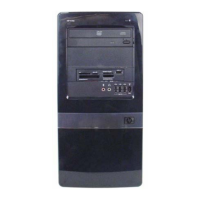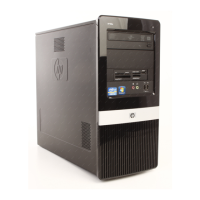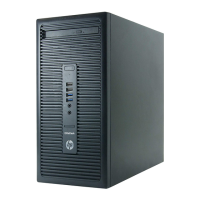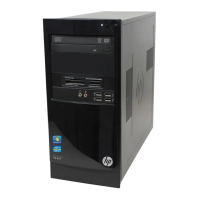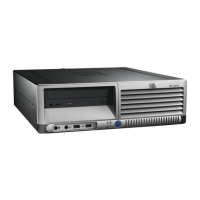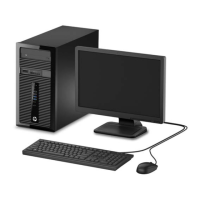Why is the date and time wrong on my HP Elite 7500 Microtower?
- SSandra SimmonsSep 7, 2025
If the date and time display on your HP Desktop is incorrect, the RTC (real-time clock) battery may need to be replaced.
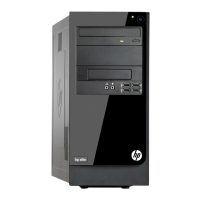
Why is the date and time wrong on my HP Elite 7500 Microtower?
If the date and time display on your HP Desktop is incorrect, the RTC (real-time clock) battery may need to be replaced.
What to do if HP Elite 7500 Microtower is locked up and won't turn off?
If your HP Desktop appears locked up and won't turn off when you press the power button, it could be due to a software control issue. Press and hold the power button for at least four seconds until the computer turns off. Alternatively, disconnect the power cord from the electrical outlet.
How to fix 'drive not found' on HP Elite 7500 Microtower Desktop?
If a drive is not found or identified on your HP Desktop, check cable connections. If it is a newly installed device, see reconfiguration directions in the Solving Hardware Installation Problems on page 187 section. If the system still does not recognize the new device, check to see if the device is listed within Computer Setup. If it is listed, the probable cause is a driver problem. If it is not listed, the probable cause is a hardware problem. For a newly installed drive, run the Computer Setup utility and try adding a POST delay under Advanced > Power-On. Also, check that the device is attached to a SATA port that has been hidden in Computer Setup by running the Computer Setup utility and ensuring Device Available is selected for the device's SATA port in Security > Device Security.
How to fix hard drive error on HP Desktop?
If a hard drive error occurs on your HP Desktop, use the error-checking tool in Windows. In Windows XP, right-click Start, click Explore, and select a drive. Select File > Properties > Tools. Under Error-checking, click Check Now. In Windows Vista or Windows 7, right-click Start, click Explore, and right-click on a drive. Select Properties then select the Tools tab. Under Error-checking click Check Now. Alternatively, use a utility to locate and block usage of bad sectors. If necessary, reformat the hard disk.
What does 'Nonsystem disk' mean on my HP Elite 7500 Microtower Desktop?
If you receive a 'Nonsystem disk/NTLDR missing' message on your HP Desktop, it means the system is trying to start from a non-bootable diskette. Remove the diskette from the drive. If the system is trying to start from the hard drive, but the hard drive may have been damaged, insert a bootable diskette and restart the computer. Check the hard drive format using fdisk. If it is NTFS, use a third-party reader to evaluate the drive; if FAT32, the hard drive cannot be accessed. You may also need to install system files for the appropriate operating system.
Why won't my HP Elite 7500 Microtower Desktop boot from the hard drive?
If your HP Desktop will not boot from the hard drive, make sure that the device is available in the Computer Setup utility, ensuring 'Device Available' is selected for the device's SATA port in Security > Device Security. Also, verify that the boot order is correct in Storage > Boot Order. Ensure that the Hard Drive's “Emulation Type” is set to “Hard Disk” in the device's details under Storage > Device Configuration. If the front panel Power LED is blinking RED and beeps are heard, refer to Appendix A, POST Error Messages on page 150 to determine possible causes.
Why is my HP Desktop experiencing poor performance?
Poor performance on your HP Desktop can stem from several factors. The processor may be overheating, so ensure that airflow to the computer is not blocked and that fans are connected and working properly. A full hard drive can also cause performance issues, so transfer data to create more space. Insufficient memory can be another cause, so consider adding more memory. Other causes include a fragmented hard drive (defragment it), a virus (run a virus protection program), or too many applications running (close unnecessary ones). Some software, especially games, may require lower display resolutions for better performance.
Why is my HP Elite 7500 Microtower locked up?
If your HP Desktop seems to be locked up, it may be that a program in use has stopped responding to commands. First, attempt the normal Windows “Shut Down” procedure. If this fails, press the power button for four or more seconds to turn off the power. To restart the computer, press the power button again.
Why does my HP Desktop power off and flash a red light?
If your HP Desktop powered off automatically, the Power LED flashes red two times, and the computer beeps two times, it indicates that the processor thermal protection has been activated. Ensure that the computer air vents are not blocked and the processor cooling fan is running. Open the hood, press the power button, and see if the processor fan spins. If the fan is not spinning, make sure the fan's cable is plugged onto the system board header. If the fan is plugged in but not spinning, replace the heat sink/fan assembly. If problems persist, contact an authorized reseller or service provider.
How to fix no sound on HP Elite 7500 Microtower Desktop?
If there is no sound or the sound volume is too low on your HP Desktop, check the F10 BIOS settings to ensure the internal system speaker is not muted. Also, make sure the external speakers are properly connected and powered on, and that the speakers' volume control is set correctly. Use the system volume control in the operating system to ensure the speakers are not muted and to increase the volume.
| Form Factor | Microtower |
|---|---|
| Processor | Intel Core i5 or i7 (varies by model) |
| RAM | Up to 32 GB |
| Storage | Up to 2 TB HDD or 256 GB SSD |
| Graphics | Integrated Intel HD Graphics or optional discrete graphics |
| Optical Drive | DVD-ROM |
| Audio | High Definition Audio |
| Networking | Gigabit Ethernet |
| Ports | USB 2.0, USB 3.0, Audio In/Out, VGA, DisplayPort |
| Operating System | Windows 7 Professional |
| Power Supply | 300W |
| Expansion Slots | 1 PCIe x16, 1 PCIe x1, 1 PCI |
Identification of components in the microtower chassis.
Identification of components in the small form factor chassis.
Steps for automatic operating system installation.
Procedure for downloading and installing Windows updates.
Overview of Computer Setup utility functions.
Steps to access and navigate Computer Setup.
Security settings within Computer Setup.
Power management settings in Computer Setup.
List of spare parts for the Microtower chassis.
List of spare parts for the Small Form Factor chassis.
Lists of available hard drives and optical drives.
Lists of various motherboard components like graphics cards.
Characteristics and specifications of SATA hard drives.
Guidelines for using SATA data cables.
Hazards and prevention of Electrostatic Discharge (ESD).
Precautions to prevent damage from ESD.
General guidelines for proper computer operation.
Procedures for cleaning computer components.
Tools and software needed for computer servicing.
Steps to prepare the computer for component removal.
Procedure for removing the MT chassis access panel.
Information and part numbers for memory modules.
Procedure for removing memory modules.
Lists of available expansion cards.
Lists of available drives and their part numbers.
Procedure to remove an optical drive.
Procedure to remove a hard drive.
Lists of processors and their part numbers.
Procedure to remove the power supply.
Lists of system boards and their part numbers.
Steps to prepare the SFF computer for component removal.
Information and part numbers for SFF memory modules.
Procedure for removing memory modules from SFF.
Lists of available drives and part numbers for SFF.
Procedure to remove an SFF hard drive.
Lists of processors and their part numbers for SFF.
Procedure to remove the SFF power supply.
Lists of system boards and their part numbers for SFF.
Pin assignments for USB connectors.
Pin assignments for DVI connector.
Pin assignments for 24-pin ATX power connector.
Pin assignments for PCI Express connectors.
General requirements for power cord sets.
Specific requirements for Japanese power cords.
List of POST error codes and text messages.
Guide to understanding front panel LEDs and audible codes.
Guidelines for a safe and comfortable work environment.
Steps to take before contacting technical support.
General troubleshooting suggestions.
Common computer problems and their solutions.
Troubleshooting steps for power-related issues.
Troubleshooting steps for memory issues.
Troubleshooting steps for display issues.
Troubleshooting steps for audio issues.
Steps to reset the password jumper on 3300/3305 models.
Steps to clear CMOS settings on 3300/3305 models.
Guide to backing up and recovering data in Windows 7.
Tools and procedures for system recovery.
Instructions for using the F11 recovery tool.
Technical specifications for the Microtower (MT) chassis.
Technical specifications for the Small Form Factor (SFF) chassis.
